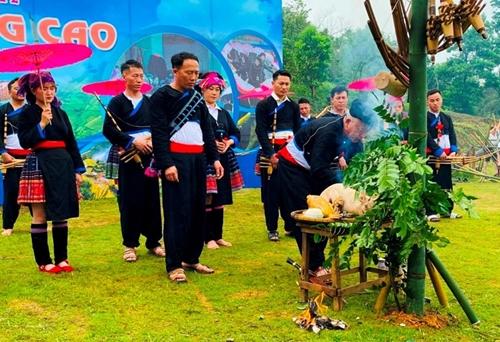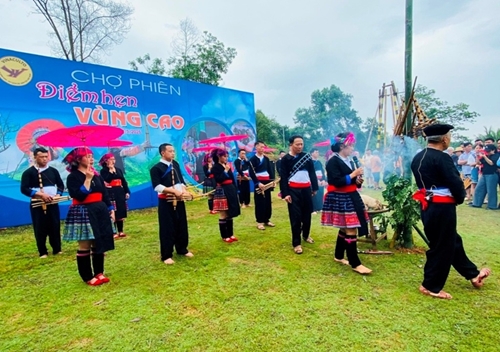Amid the nationwide celebrations marking the 50th anniversary of the South Liberation and National Reunification Day (April 30, 1975 - 2025), the spirit of unity was vividly showcased at a grand festival at the Vietnam National Village for Ethnic Culture and Tourism (Ha Noi), where the Gau Tao festival of the H'mong people was revived.
As visitors walked into the festival grounds, the sounds of the khen echoed in the air. Against the backdrop of a sunny early summer, the traditional costumes of the H'mong people seemed to bloom under the bright sky, creating a space full of festivity, culture, and identity. The festival was not just a performance; it was an immersion into the deep soul of people who have lived resiliently in the mountains, carrying with them ancient customs and beliefs.

The ceremony leader and villagers stand around the neu tree, preparing to carry out the ritual offerings.
The Gau Tao festival (meaning “outdoor play” or “hilltop festive event” in the H'mong language) has long been an essential ritual for the H'mong people in Northern mountainous provinces such as Lai Chau, Ha Giang, and Lao Cai. It is a time to pray for health, children, safety, and to express gratitude to the gods, the earth, and ancestors, while also serving as a community gathering for socializing and relaxation after hard work.
The festival is typically held between the third and the 15th of the first lunar month. H'mong people believe that such festival, conducted on a high hill in open spaces surrounded by lush greenery, bring people closer to the sky, to their ancestors, and to the Earth.
According to folk legend, in the past, if a couple who had been married for a long time were unable to have children, the husband would climb a hill to pray to the mountain and forest gods for a child. If the wife later gave birth to the child they desired, the family would hold a Gau Tao festival as a thank-you offering to the gods, a tradition that has been passed down through generations.

The Gau Tao festival, being revived, is not just a festive occasion but also an opportunity to educate younger generations about their heritage and cultural identity.
At the festival grounds in the Vietnam National Village for Ethnic Culture and Tourism, the event was organized with all the traditional rituals. A tall neu tree (symbolic of the connection between the Earth and heaven) stood in the center of the field, surrounded by offerings like boiled chicken, banh giay (sticky rice cakes), corn wine, and incense. The neu tree was carefully selected and erected to ensure it faced the rising sun, with its leaves trimmed to symbolize the connection between humans and celestial beings.
From the early morning, villagers arrived at the festival. Elders led the younger ones, and young men and women donned their finest traditional attire as they walked together to the festival. After the ritual offerings, the traditional khen music was played, and dances swirled through the lush grass. Folk games such as stick pushing, tu lu (ball games), and pao (fabric balls) throwing attracted both participants and onlookers.
But beyond the festivities, the festival served as a living classroom where the younger generation learned about their roots and culture. Young girls practiced playing the khen, young men carved their tu lu balls, and elders shared the stories of the festival’s origins and the significance of the neu tree and offerings. The Gau Tao festival has become a place for all generations to connect with the past and rekindle traditional values.
Artisan Giang Thi Ma, a H'mong artisan living at the Vietnam National Village for Ethnic Culture and Tourism, shared that listening to the sound of the khen and watching the synchronized dance steps around the neu tree, she felt as though a piece of the spirit of the Northwestern mountains was with them. They were very happy and proud that the Gau Tao festival of H'mong people was being revived at this gathering. Not only the H'mong people, but also visitors from all over the country have the opportunity to learn more about their customs and culture. She underlined that this is a great joy because their festival is not lost but is cared for and preserved by the State.
Director of the Department of Culture and Ethnic Affairs under the Ministry of Culture, Sports, and Tourism Trinh Ngoc Chung held that in recent years, the Gau Tao festival has been revived at the Vietnam National Village for Ethnic Culture and Tourism in collaboration with H'mong people. This festival not only holds deep spiritual meaning, but also plays a crucial role in preserving and promoting H'mong ethnic culture. They work closely with artisans and elders to pass on the rituals, traditional games, and songs to younger generations, and also link the festival to community tourism development.
The Gau Tao festival is not only a cultural gathering, but also an important educational tool, teaching the younger generation about their heritage, the natural world, and the values of unity and respect. Its revival in Hanoi not only brings joy and pride to H'mong people but also helps enrich the cultural tapestry of Vietnam, showcasing the nation’s rich diversity.
Translated by Chung Anh